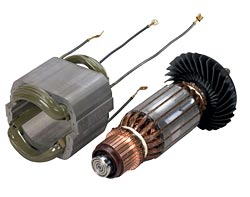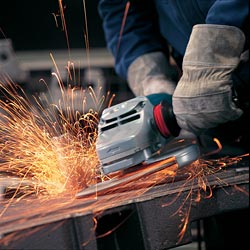Copper Puts the "Power" in Power Tools
Today's do-it-yourselfers have a bottomless toolbox of technology to help with any and every project. Air compressors, circular saws, biscuit joiners, jigsaws, impact wrenches - no matter which power tool you reach for, technology makes the job easier.
With most power tools, improvements in technology usually start at the motor, and virtually all electric tool motors, both cordless and plug-in, depend heavily on copper for power. As it turns out, "heavily" is not an understatement.
"Generally speaking, the more copper mass in the motor, the more powerful the motor is," explains Deborah Brown, the component design manager for Bosch Tool Corporation. "To increase the power of our motors, manufacturing is challenged to fit more copper wire into the motor."
A motor's expected service lifetime is also strongly influenced by the size and number of copper components it contains, says Brown. Power tools now include sophisticated electronics - all requiring copper circuitry - to monitor tool performance and optimize tool usage and life.
The technology that copper supports covers a wide range of features. For Bosch's reciprocating saw, electronics monitor the torque load at the motor and adjust the power to maintain a constant speed at the blade for a smooth, consistent cut. Electronics also improve safety by sensing overload and shutting off power to prevent damage to the tool, or the user.
Another engineer for a tool industry powerhouse, DeWalt, also points out how copper influences the advanced electronics in certain lines: "One area where copper will play an increasingly important role in the power tool industry is in the copper traces and heat sinks on the PCBs of our electronic controls," said engineering director of AC electrical systems, Garret McCormick. In other words, copper plays a major role in the circuit boards where the transfer of heat is necessary for cooling - similar to computer motherboards.
"As power densities have increased and the cost of sophisticated electronic controls drop, we continue to see greater integration of electronics in our products to enhance performance and to provide exciting control features." Examples of these innovative features include overload protection, soft start, or stall sensing technology like the "bind-up" control in DeWalt's stud and joist drill.
The alternative to copper that some companies turn to in power tools is aluminum, but copper has several advantages over its competitor. "Copper tends to be more malleable and less prone to the effects of residual stress, so it lends itself to mechanical and thermal fusing processes when terminating. Similar terminations using aluminum wire require considerable more care and attention," McCormick said. "So, while you may see simple examples of terminals or lead wires crimped or fused to aluminum wire, the technical and process control challenges associated with the aluminum wire to copper commutators still appear daunting."
Aside from copper's unique characteristics that make it a perfect fit for electronics, there are also other reasons why copper is so important in the production of power tools. "Copper wires are cost efficient for universal motors," Brown said. "Universal motors are 'old' technology which hasn't changed much since the early 1900s. They are easy to manufacture and work effectively within power tools and have a simple, robust design."
Moving forward, better computer modeling programs will allow companies to design motors that provide high power in a smaller, lighter weight package. And that is the direction for a lot of future tools. "The reduced weight is a large benefit to a professional using a tool for hours a day," Brown said. "Additionally, a DIY user is better able to control and operate smaller, lighter weight tools."
Regardless of the type of technology or motor that is incorporated in a power tool, you can expect to see one constant according to McCormick: "While configurations and theories of operation may differ between motor types, they all will employ significant copper content to convert electrical energy into the mechanical energy required to drill, cut, or grind." Cu

 Old vs. new motor. Photo courtesy Bosch.
Old vs. new motor. Photo courtesy Bosch.  Photo courtesy Bosch
Photo courtesy Bosch